We had our first session of Sorcerer & Sword yesterday!
The pitch was this:
There is a hidden forest valley between the perilous ridges: THE KL’AU.
The only way to reach it is a hard-to-find pass called the Fraustgap, lost in the no man’s land between three civilizations. Rumor has it there are survivors of an old prefecture there, living hard-bitten lives surrounded by harsh, sprawling wilderness. Did I mention necromancy? Rumor has it, it is a nest of necromancy most foul.
Humanity is MERCY and BELONGING.
Check for Humanity loss when you sever someone from their home, their community, their most precious personal belongings, or their identity. Check for Humanity loss if you refuse mercy to anyone who asks. And if someone has shown you mercy or broken bread with you, check for Humanity loss when you kill them.
Check for Humanity gain when you offer mercy (clothing, bread, healing, shelter, etc.) to a stranger; when you offer fellowship to an enemy; or when you restore someone to the home, community, precious belongings, or the identity that has been severed from them.
Demons are the NAMELESS shadows of FORGOTTEN things.
This includes the dead, doomed to Oblivion; the lore and artefacts of Forgotten Ages; traumatic personal memories taking on lives of their own; and savage, hostile forces of nature mingled with cunning pagan things.
Also, demons don’t exist. Sorcerers mustn’t fool themselves.
Lore is the dim memory of a FORGOTTEN AGE.
A fading echo of the world before it was sundered. Lore is a body of absurd legends, heretical doctrines, and fragmentary prophecies about the Forgotten Age and the age to come. The lore that has survived is often deeply cryptic and esoteric, almost always in dead Old Rumadhic script. Masters or lore claim that it contains coded messages that would be deemed heretical in the Magisterium and Adûn.
Sorcery invokes lore by finding the right words, and speaking written inscriptions out loud, at the ordained places and times, in the presence of blood and fire.
Sorcerers are the pulp fantasy heroes and villains who search out the Nameless, the Lost, and the Forgotten, to master the unrivaled power of the Forgotten Age.
Characters and diagrams
Ghanna and Chaser are two characters we played in another campaign that took place nine or ten years in the future. In that game we learned offhand that they met once before, when they both got entangled hunting necromancers in the wild forest region.
After two sessions of character creation Q&A and sharing, I took Ron’s advice and drew the initial diagrams myself, using the kickers and other content that the players gave me. We started our first session with each player doing a show-and-tell with their diagrams to surface any confusion or surprises.
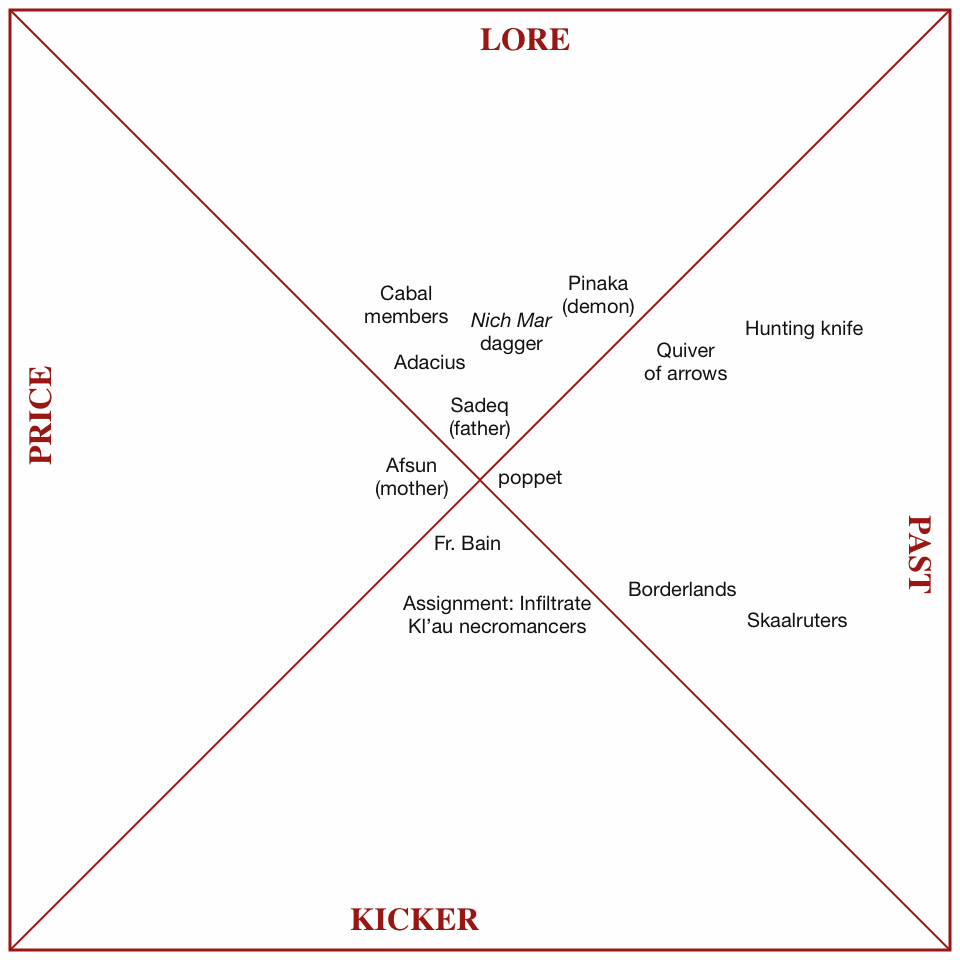
Ghanna comes from a conflicted family. Her grandfather was a priest of the Magisterium who turn his own wife over to the Inquisition as a necromancer. Ghanna learned sorcery from her father in among a desert cabal. But when she saw him sacrifice a sickly child, she reported him to an Inquisitor visiting a nearby city. Her mother threw her out, and she went to her grandfather. Desperate for a sense of belonging and to prove her loyalty to the true faith, she agreed to be his child soldier and spy by infiltrating a ring of necromancers in the Kl’au.
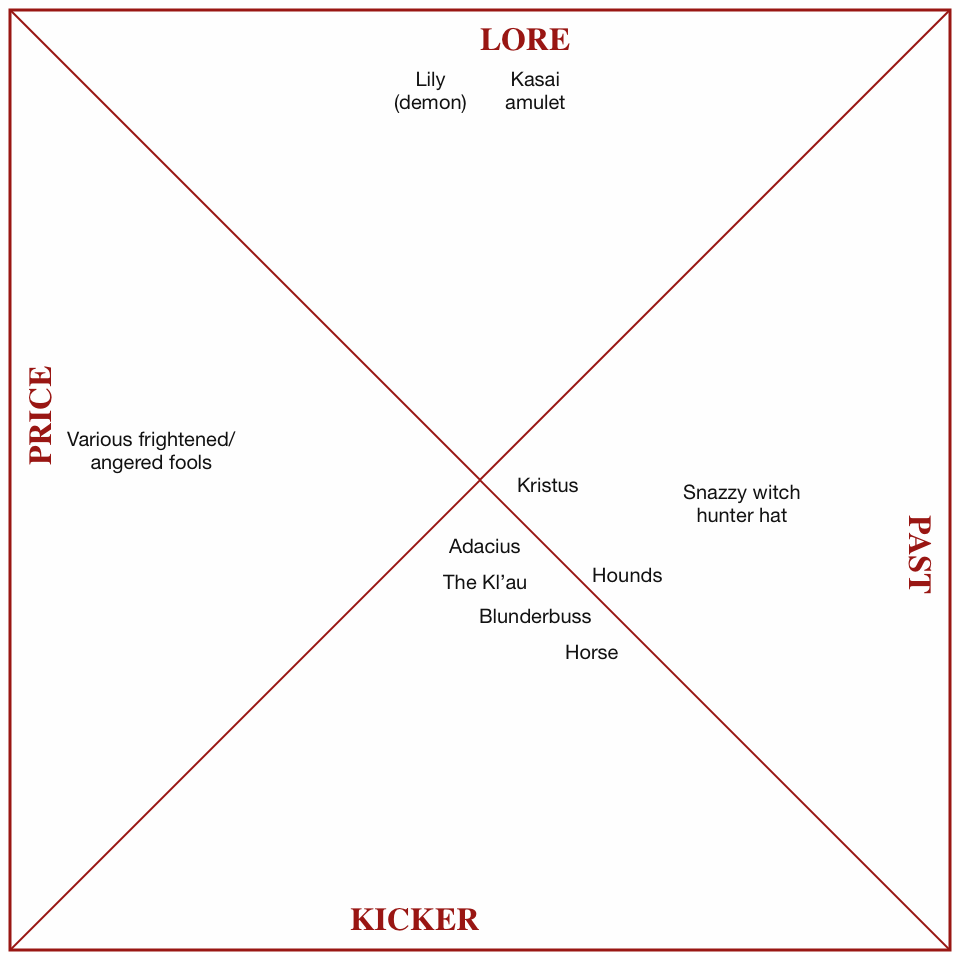
Malcolm Chaser is an Inquisitor and witch hunter whose wife was murdered by witches. He recently got a letter from an operation in the Kl’au, informing him that his own mentor went missing while rooting out the heresy there. He was asked to round up some cutthroats and come there to search for the missing Inquisitor.
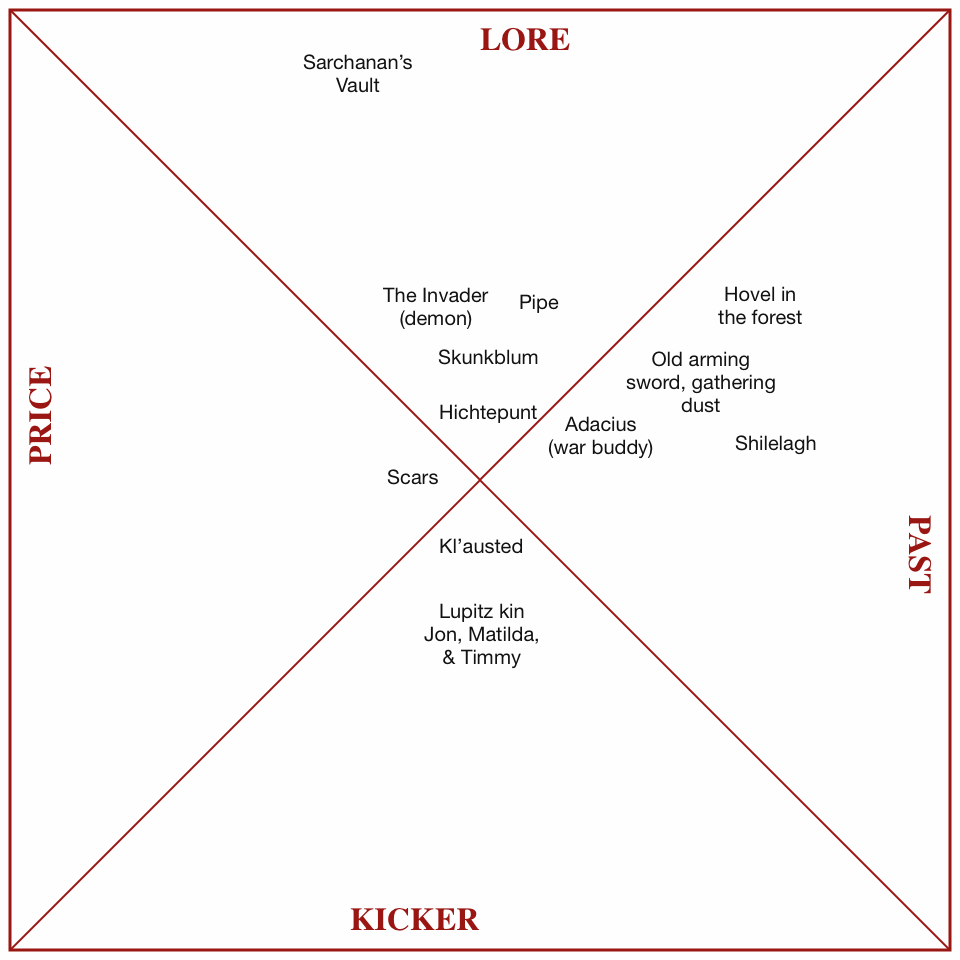
Krenzi Lupitz is a veteran of the endlessly transforming conflict between the Magisterium and Adûn. During his military service, he was captured by the enemy and ruthlessly tortured. When he gained his freedom, he fled to the borderlands to live as a hermit, and never again be caught in the wars of men. He recently learned that his last surviving kin were murdered, provoking him to leave his hovel and find the perpetrators.
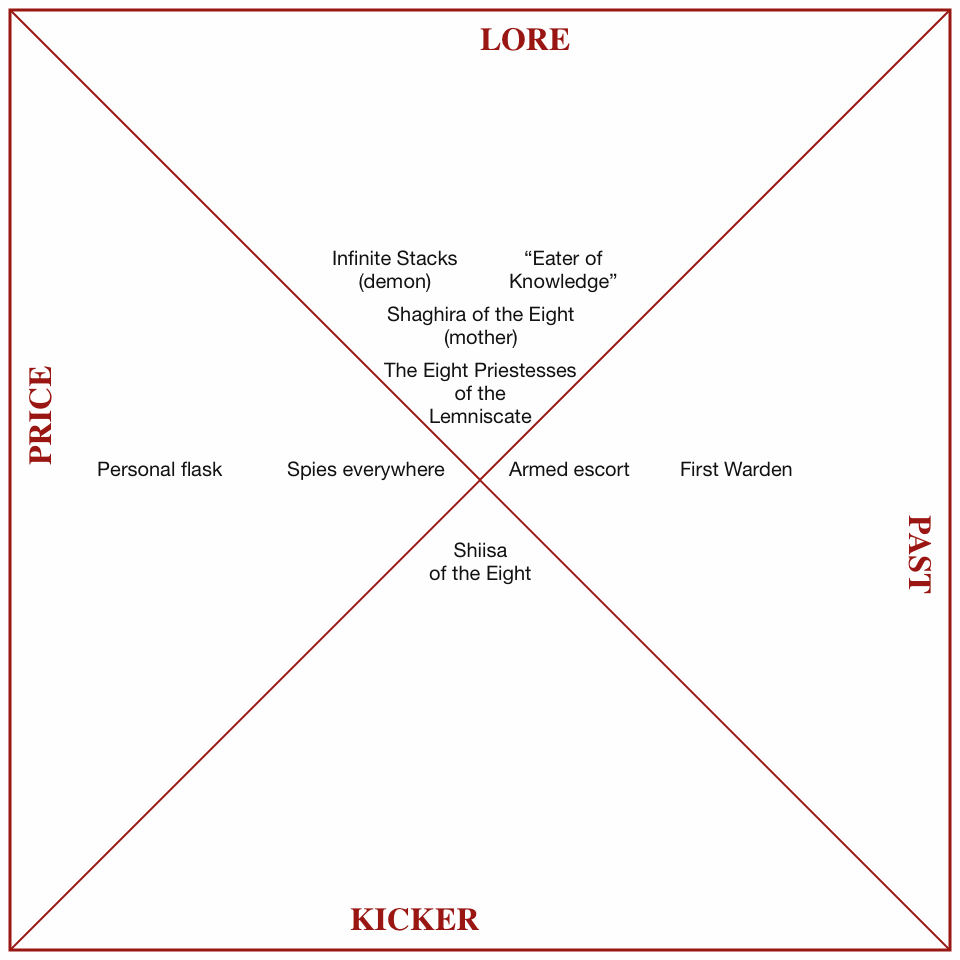
Tulasa is a member of an ancient order tasked with guarding the Magisterium’s knowledge. Before she was slain by the Eater of Knowledge, Tulasa’s mother surrendered her demon to him—a vast library of all notable history, past and future, hidden in an apparent “pocket universe” accessible only by a key in the form of a sword. Tulasa got a report that a priestess who served with his mother was taken as a captive into the Kl’au, and of course he knows it’s a trap laid before him by the Eater of Knowledge.
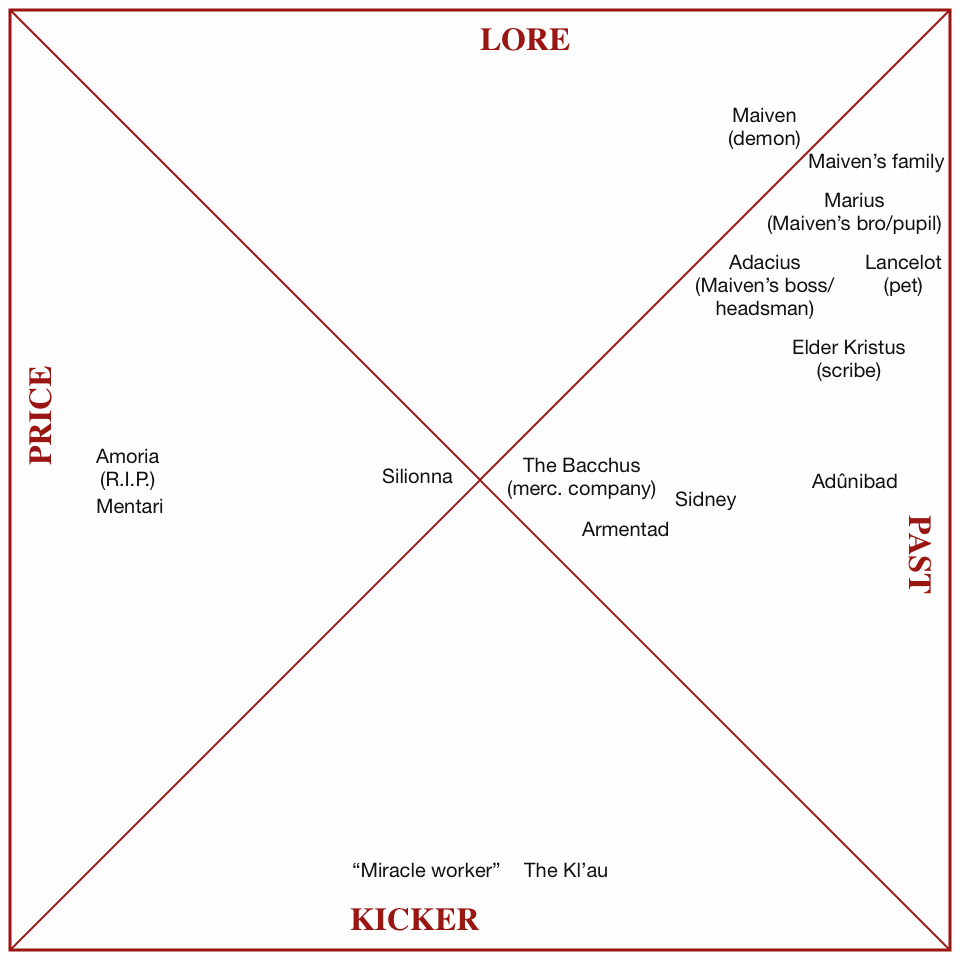
Duke Ahwe is a 500+ year old half-human and therefore undying. The event that severed his soul in two was so traumatic he can’t remember it, but he is aware that his other half is out there somewhere. He has been involved in organized crime, founding a mercenary crew, and hunting artifacts for his antique business. Recently rumors came to him that someone looking like him has been working miracles in the borderlands, before disappearing into the Kl’au.
Binding the Demons
After doing some show-and-tell with the diagrams, we went around to resolve how each player bound their demon, so that we could make their Binding rolls and Humanity checks.
I wanted to make all sorcery in this setting Humanity-relevant, and I told them to bind a demon, the ritual must involve renouncing and destroying (at least symbolically) some part of your identity, something unique and precious that makes you who you are. Examples include your home, your community, an honorific, a precious belonging, or even a bodily feature. This got everyone describing really vivid binding rituals that were awesome to behold—and much richer than I expected from a first session of Sorcerer with players new to the game. Some of the scene setting included what would be Contacts and Summons in actual play, but we didn’t make separate rolls for those and I didn’t press the distinction.
It made me wonder, though, if you typically have such vivid scene setting and action for the binding of their starting demons. Since Binding is the one ritual where the sorcerer’s active score depends on the circumstances, it seems to be required.
- Ghanna’s renunciation was of her father, over the bonfire where his corpse smoldered, as she took up his bow and called on the spirit of the sickly child he killed to inhabit it.
- Chaser described slaying the witches who killed his wife, as her body lay cold and his fellow witch-hunters lay dying from their wounds around him. Desperate to keep his wife, he threw his holy symbol in the fire and took up the heretical amulet the witches were using in whatever ritual they killed his wife for. To conceal his heresy, he killed the wounded survivors of his own team. The twisted memories of his wife possess him now.
- Krenzi described a scene in the dungeon where he was tortured. Covered in his own blood, he marked the walls with it while calling upon his demon—known only as the Invader—to give him power to survive and overcome. After the game the player and I realized we both forgot to describe what he renounced of his identity!
- Tulasa’s renunciation involved going to his father’s grave with a pickaxe to wipe out his father’s name and reduce the markers to pebble-sized rubble.
- Duke Ahwe’s love was a soldier of the Inquisition. When her mentor learned that she was learning sorcery (from Ahwe), he had her killed. Duke took her sword and destroyed the memento of a former lover from his long life, in order to appease his slain lover’s spirit in the sword.
That’s all I have time to write for now, but I’d love to report what happened once we started framing scenes based on the diagrams later.

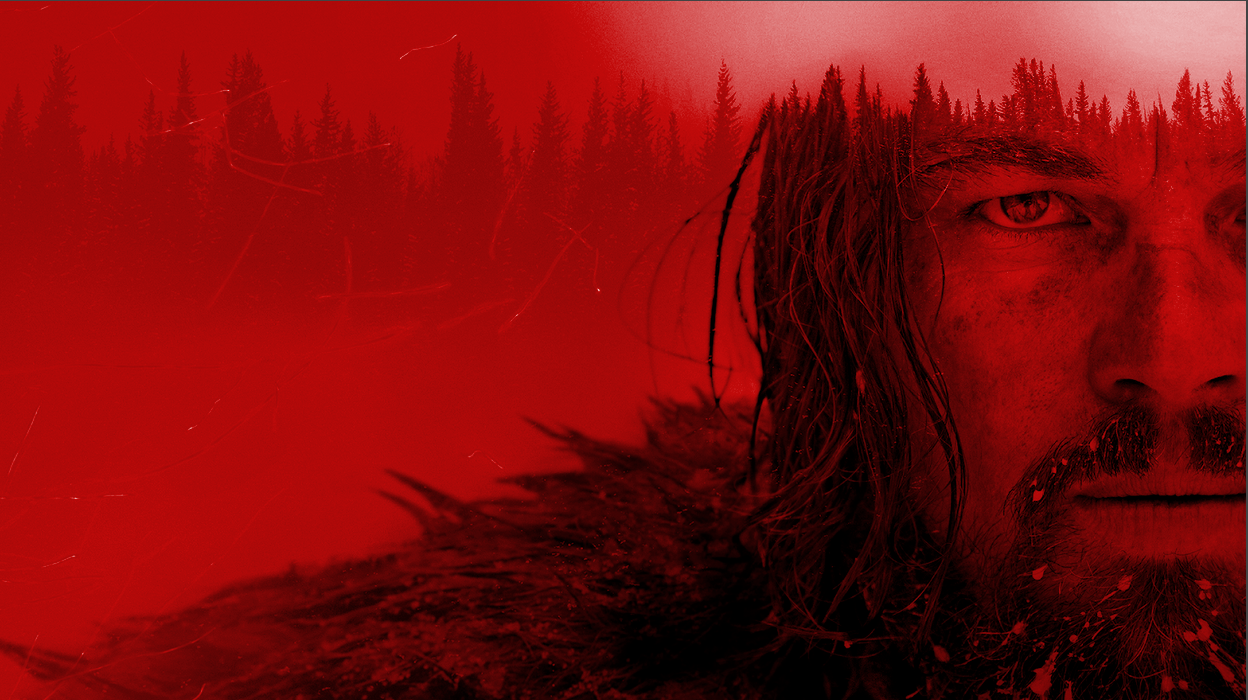
19 responses to “Sorcerer & Sword: Into the Kl’au first session”
I just spotted my first mistake…
Oops! I just spotted this comment:
For some reason, I thought maintaining the diagram was a player-facing responsibility. That’s a major reason I spent the beginning of this session going over the initial diagrams—so they could see how it was done.
I must say, there is some relief in taking responsibility for this as the GM. Especially in the era when we are all playing remotely, facilitated by telecommunications tech, “passing papers around the table” is much more challenging.
I still don’t regret setting aside time for diagram show-and-tell, though. For one, I added some locations and possessions to the diagrams that I thought were strongly implied. Since they had never done this before, they sincerely didn’t know what was needed, and some were sparse on details. Having the show-and-tell gave us a chance to resolve any critical confusion or miscommunications before they grew in gravity.
The process also gives me some confidence that we will all be stronger with player-initiated diagrams next time we play Sorcerer, provided there is some repeat players!
Hi! As I understood it:
Hi! As I understood it:
– Ron's advice in this comment is focus on my game, where all the players were knew to Sorcerer. As he said, there is a lot to internalise and digest for new players, and it's better that the GM deals with the diagram for the first game. I think that it is in this context that he says "don't mistake it with players".
In this discussoin https://adeptplay.com/actual-play/sorcerer-and-sword-debriefing-adventuring-world-hybreasil and particularly this video's answer, Ron clarifies how the diagram works. I don't know for you, but I realised I did lots of thing wrongs (such as trying to making scenes of a story by associating things.. it's way more simpler than that, and "if in doubts, the player just says where the things are".
Here is the answer : https://adeptplay.com/comment/3264#comment-3264
Thank you, Greg! I’ll look
Thank you, Greg! I’ll look those comments over as soon as I can. I did watch the videos linked in that thread without even knowing about the related discussion, and that guidance very helpful and very much on my mind as I composed the diagrams for our first session.
TL;DR:
TL;DR:
I wonder, for Sorcerer, do you have any criteria for removing items from the diagrams between sessions—besides utter destruction of an item? Or is it more of an art, and you use your aesthetic intuition?
I'm asking because players put some stuff on the lists for their diagrams that was like, 1,000 miles away. And other items might jump up or recede in relevance from one session to another.
Details:
Like I said above, I asked them for the items listed under Price, Lore, Past, and Kicker, and I placed them on the diagrams. The players had diverse understandings of what that meant. Because this was their first run, some of their headings were altogether empty, leaving the diagrams sparse. For those, I added a few nouns that they had mentioned or were heavily implied by their stories-so-far.
And one player listed enough disparate items to populate more than a lifetime of fantasy adventure. (Fittingly, it was the character with Past: Immortal.) For that, my hunch is he was throwing a lot at the wall to see what sticks, like someone submitting a detailed back story for a “role-playing character”.
Before we go there, maybe it would help to talk about a more clear-cut example, or so I think. Ghanna’s diagram lists her father and sorcerous mentor Sadeq (deceased), her mother Afsun, her grandfather Father Bain, and a poppet that Ghanna’s grandmother made for Afsun as a child—the poppet that got her turned in for witchcraft. Ghanna’s Price is arrogance, and Afsun is in that quadrant because she was outraged over Ghanna turning Sadeq in to the Inquisitors. Afsun sees her own father’s arrogance recapitulated in her daughter.
Because the father, mother, and grandfather are in three adjacent quadrants, they got pulled to the center for our first session, producing a pretty emotionally explosive scene. I plan to post a separate recap of those events, but the result was that Afsun turned around to go home, hundreds of miles from where they met, and Ghanna turned to go hundreds of miles in the exact opposite direction.
Not only that, but Ghanna’s Binding ritual, which I wrote about above, had her renounce Sadeq as his body was consumed by flames. It seems clear that his name is warranted for removal. It also seems clear based on the events of the session that the poppet would move from Past to Price: Afsun threw the poppet at Ghanna to show her the reason her grandmother is dead (Bain’s arrogance). Ghanna held on to it, but she unequivocally sided with Bain.
There will be additions to the diagram too, but those two changes alone would completely change the center of the diagram: Sadeq is no longer there to attract Afsun to the border with Lore, and the poppet is in the same quadrant as Afsun—so they no longer get drawn to the center. Supposing Father Bain and Afsun are still linked, that drives them to the border between Price and Kicker, since Sadeq and the poppet are no longer in adjacent or opposing quadrants to draw them to the center.
Like I said, this seems like a clear-cut case where deleting an item is required, and shifting an item feels necessary. Do I have that right so far?
Duke Ahwe’s diagram feels like a more fraught example, but maybe not. Duke Ahwe is the lone Immortal character in our game, and the player gave me a lot of background—way more than I would consider typical or desirable for Sorcerer. But I put every item he listed on his initial diagram and we framed the first scene with those elements implicated at the center.
Because of events in play, Duke’s demon Maiven (under Lore) took an interest in Ghanna (a new item under Kicker). Being in opposing quadrants, that would bring them to the dead center.
But Maiven was previously linked to all of Maiven’s family, who are geographically hundreds of miles away. And like Ghanna, Duke and Maiven have set out in the exact opposite direction. No matter how motivated they are, I just don’t see them making the harrowing journey across the savage continent and through a trecherous mountain pass to find Maiven-as-sword. My impression of them from the player is that he saw them more like the Darling parents in Peter Pan: mundane folks who are separate from “the actual adventure”.
If we go back to any place they could reasonably be, I would absolutely look for ways to question or subvert that assumption. I love role-playing that is grounded in personal, family drama, with real human desires in play. But at this point, they feel somewhat extraneous.
However, if they maintain their connection to Maiven, having her go to the center of the diagram makes them trail along behind her. As I think this through now, this might simply mean that Maiven is homesick and concerned about her family—which may be challenging for Duke to divine from his sword. I guess this is clashes with my initial question, but I’m starting to see how that could continue to play an interesting role in whatever surfaces as the central conflict.
Hmmm. I’m still interested in hearing what standards you all have for pruning items from the diagrams, whether they definite and fixed, or loose and intuitive.
Thanks!
It’s taken me a while to
It’s taken me a while to clear through some of the local table-decisions or context in order to get to the questions I can answer. I might have to revisit some of the things I’m stepping past, depending on how the answers go, but with any luck not.
Question 1 (paraphrased): The diagram may have things in it which are neither in the center nor even remotely relevant to what’s going on as indicated either by the Kicker or other things in the diagram. Can I remove them? How, meaning, by what procedure or criteria?
I look at this issue very differently. To me, a character’s diagram has about a thousand things on it, and we’re only looking at an explicit subset at any given time. Say a person has “my house” on the character’s diagram. To me, that’s everything in it, as well as its every physical, cultural, historical, social, and economic feature. It includes the people who lived in it before the character did, it includes the houses on either side of it, and it includes the house the character lived in before coming here, even if the latter house is precisely on the opposite side of the Earth.
Therefore if anything is on the diagram which isn’t connecting up with anything else, and isn’t even located particularly near anything that’s apparently going on right now, well, so what? There is no hard distinction between things which are on the diagram and things which aren’t. Both for things which are on there and for things which are not, the GM is perfectly capable of having them act and operate.
Worst-case scenario regarding those “orphan” or “away” things? That my GM job is to know what they’re doing, if even what they’re doing is harmless, irrelevant, and separate from whatever we happen to be doing in play. Which is not “worst” at all, but merely part of the job.
It may help to recall that the diagram concerns the opening situation of the upcoming session, not the entirely of a session’s contents or what the session is “about.”
Consider as well that when the diagram gets redone (by the player) for each session, the things on it do not move – instead, you redraw it from scratch based on where the things on the lists now are, and obviously, the lists are also made from scratch based on whatever is going on. So the player themselves may choose to keep the long-lost far-away not-currently-relevant parents (or dog, or house, or intestines in a jar, or whatever) on the diagram, or they may not. It’s not your problem, and if they removed something that you think should stay, well, like I said, you get to play anything in play, diagram or diagram, so again, no big deal.
Does that help at all? I simply see no issue whatever in your question, not even a question.
Thank you, Ron! That makes
Thank you, Ron! That makes perfect sense. Maybe you can see that this was all starting to dawn on me as I wrote about Duke Ahwe’s diagram. I appreciate the guidance to simply pay attention to the status of each item on the diagram, in all aspects of what it represents, whether it seems like it will be focal in the next session or not. I can handle that! Thank you again.
When I contrast what you’re
When I contrast what you’re saying here with your comment that I linked above, it sounds like “maintaining the diagram” is a conversation between each player and the GM, not exclusively up to one party or the other. Is that right?
On one hand…
And on the other…
It sounds like a practical regime for me is to add it to our end-of-session discussion, since I won’t have time during the week to chase down each player for one-on-one discussions:
“Looking at the items on your diagram, do you see anything you’d like to remove or notice anything missing that you’d like to add? Please let me know how your lists would change, if at all.”
Then I can use what they give me to generate new diagrams, per the clear instructions you provided on how things get grouped.
Or would you say it’s a misunderstanding to mix your advice here with the contrasting guidance you offered in that thread?
Thank you again! While I’m very interested in the mechanics of this, I’m mainly just happy to be playing Sorcerer. We had a thrilling second session today, and I don’t want to give the impression that these technical questions are holding us back from a very rich experience so far!
Well, this is one of those
Well, this is one of those trapdoor topics for which I have pre-written some “saves,” for this conversation. I hope it isn’t too mean-sounding.
I can’t unpack what I’m saying about who writes the diagrams. This isn’t about contrasting advice from me. Your reading of the post with Greg, your reading of the text, and what you’ve taken from our conversation has written yourself into a corner about it, and I can’t get you out. I have to say, please just torch everything that’s brought you to this question.
The procedure is this: players write their diagrams, the GM uses them for preparing the next session. For first-time players, I’ve very reluctantly found it necessary to write the starting diagrams, and then to shift to the players doing them as a stepwise learning process. That’s it.
Your phrasing about “conversation” might also get torched, just in case it’s going a way that I fear it might. Instead, let’s try phrasing it simply as make and use, with the player doing the making and the GM doing the using. Furthermore, by using, do engage with the point I made to you above, that the diagram has a specific purpose and doesn't operate as a straitjacket concerning anything's activity beyond that purpose.
What I’m saying not to do is any kind of negotiation, chit-chat, literal dialogue between you and each player about what’s on the diagram and what it means and how it’ll be used, each time. That’s a dimension-door to hell right there. (Related: acknowledging the risk that I’m over-reading your words, I strongly advise against any degree, at all, of “we frame a scene” phrasing for the opening situations of play. That’s a single-person GM-side job.)
Thanks, that’s perfectly
Thanks, that’s perfectly comprehensible. And I’m totally sympathetic to the need for bluntness for the sake of clarity—I didn’t take it as “mean-sounding”.
It sounds like you’ve anticipated hazards I never even imagined, like kibitzing over how scenes are framed and their content or anything similar. Joyfully, I never even thought of doing stuff like that, and the prospect holds no temptation for me. “Dimension-door to hell” sounds precisely how much I would enjoy that.
“Make and use”. I can deal with that.
If it’s not contrasting advice, I have no idea what it meant when you said, “maintaining [the diagram] is the GM’s job” though. But that’s torched. Who should make and who should use the diagrams is clear now.
By the way, I don’t know how
By the way, I don’t know how productive or rewarding this thread is for anyone else—if at all. But this…
I see the clouds open and I hear the universe singing to me. Love it!
That’s because I fucked up
That's because I fucked up and said something totally backwards which I am capable of doing, sometimes more than once.
The diagram is the GM's job after play begins. I can't say that's clear or fully designed to become clear, given that it's on the player's sheet, but all this was authored before modern expectations of who has what and does what with it.
I can testify that even a
I can testify that even a fucked up understanding of the diagrams (though not too far off) has produced really riveting play for us. And it seems reasonable that novel and innovative ideas would be hard to communicate.
In all my previous Sorcerer runs, I had zero understanding of how the diagrams fit in, and did not use them. This run has been way better, and I expect it will be even better the next time we start a Sorcerer game—whether it features the same characters or an entirely new premise.
More on Humanity-relevant sorcery
I was really thrilled by the visceral detail generated by the Binding “flashbacks”. I doubt we would have come up with that stuff without the requirement that they renounce or destroy something related to their own identity. And like I said above, that came out of our Humanity definition.
When I first started putting the one-sheet together, I was having a hard time defining the look and feel of sorcery in relation to what we knew about the setting already. It’s still not perfect, but the intuition to define each ritual in humanity-relevant terms first was the inspiration I needed to make it work.
Writing or reading the right words from forgotten memories in the presence of blood and fire is a general requirement for all sorcery. But I also set down some ideas about how the rituals relate to humanity:
There are a few rituals that I’m not quite confident about yet.
As you can see, I haven’t quite connected all the dots yet. I thought it was safe to start playing, with some trust that our collective creativity would fill the gap if and when sorcerous rituals come up.
But having the Binding requirement perfectly clear produced really satisfying rituals. I have a hunch that giving similar hard requirements for the other rituals will help provide better grounding so we don’t stumble, hessitate, or flinch. Any suggestions or guidance would be very welcome!
(Credit where it’s due: My
(Credit where it’s due: My friend Tam was the one who suggested that offering the demons themselves forgiveness to punish them.)
My suggestion or guidance is
My suggestion or guidance is that you’ve gone far enough. Putting in the hard requirement for Humanity regarding the rituals was apparently a good idea for you and this group, but I caution against noting a hammer in your hand and then pounding away at more things and harder.
…I caution against noting a
This was exactly what I needed to hear. Thank you!
The necessary ritual step
… is to ask whether you want my feedback. I am typically not too gentle when talking about Sorcerer, as you may have seen in other posts. I'm also capable of staying out of a discussion if that seems like a better idea. Let me know.
That sounds ominous, but I
That sounds ominous, but I think I can take it. I already braced myself for a lot of fumbling and told the players I’m looking at this as a practice run. On the other hand, the first session was a lot of fun, and I think the practice will be rewarding as we go.
I’ve put some responses into
I've put some responses into their relevant spots above. If you have any procedural questions I'm happy to follow up.